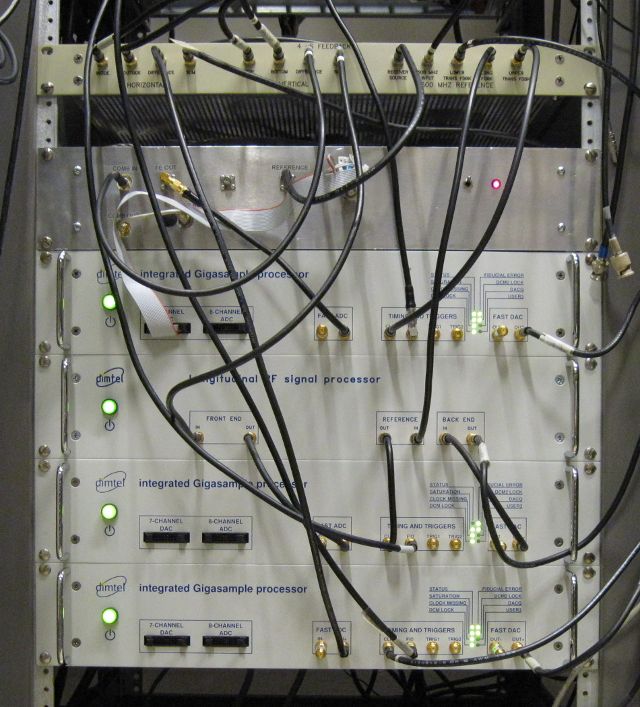Table of Contents
Bunch-by-bunch Feedback Commissioning at CESR-TA
Hardware installation
 During the week of May 18–22, 2009, three iGp-based bunch-by-bunch feedback systems were commissioned at CESR-TA. Hardware installation, illustrated on the right, consists of three iGp-1281F bunch-by-bunch feedback processors, one FBE-500L RF front/back-end unit, and a custom transverse front-end.
During the week of May 18–22, 2009, three iGp-based bunch-by-bunch feedback systems were commissioned at CESR-TA. Hardware installation, illustrated on the right, consists of three iGp-1281F bunch-by-bunch feedback processors, one FBE-500L RF front/back-end unit, and a custom transverse front-end.
In the longitudinal plane the BPM sum signal is processed by the front-end section of FBE-500L. After baseband bunch-by-bunch processing with iGp-1281F kick signal is upconverted by the back-end to the upper sideband of 1 GHz. Existing power amplifier and DAΦNE-style cavity kicker were used to apply the correction to the beam. Even though kicker bandwidth is commensurate with bunch spacing of 14 ns, it provided sufficient bunch-to-bunch isolation to control longitudinal instabilities at 4 ns spacing.
Two transverse feedback channels use similar hybrid networks at the input to generate horizontal and vertical difference signals. In the vertical plane the difference signal was processed by a custom prototype front-end unit, operating at 1.5 GHz detection frequency. After amplitude detection the signal was sampled by the iGp. In the horizontal plane difference signal was applied directly to the iGp input, such configuration made possible by wideband (3 dB bandwidth of 1.3 GHz) response of the ADC chain and high timing stability. Stipline kickers were used in the back-end. General-purpose DAC outputs integrated in the iGp were used to control the phasing of the custom prototype front-end.
Diagnostics
 In addition to stabilizing coupled-bunch motion in transverse and longitudinal planes, the systems will also be used as a powerful diagnostic tool. Feature of high interest at CESR-TA is the ability of the iGp feedback channels to measure bunch-by-bunch tunes. Plot on the left shows the result of one such measurement in the vertical plane. Train of 30 positron bunches at 4 ns spacing was filled to 20 mA. Bunch-by-bunch closed-loop spectra are plotted on the bottom. Due to the feedback action a notch forms in the spectrum of each bunch centered at the open-loop (unperturbed) tune. On the top the frequencies of spectral minima are plotted for all bunches.
In addition to stabilizing coupled-bunch motion in transverse and longitudinal planes, the systems will also be used as a powerful diagnostic tool. Feature of high interest at CESR-TA is the ability of the iGp feedback channels to measure bunch-by-bunch tunes. Plot on the left shows the result of one such measurement in the vertical plane. Train of 30 positron bunches at 4 ns spacing was filled to 20 mA. Bunch-by-bunch closed-loop spectra are plotted on the bottom. Due to the feedback action a notch forms in the spectrum of each bunch centered at the open-loop (unperturbed) tune. On the top the frequencies of spectral minima are plotted for all bunches.
In the iGp one can select an arbitrary subset of RF buckets for feedback - a critical feature for the success of bunch-by-bunch tune measurement at CESR-TA. 3.5 ns long striplines produce significant coupling between bunches 4 ns apart. Shutting off the kick for two nanoseconds in the empty buckets reduces noise coupling between bunches. Without this feature the coupling completely washes out the spectral notches.